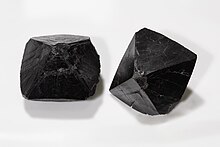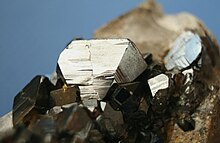Tin oxide mineral, SnO₂
| Cassiterite
|
|---|
 Cassiterite with
muscovite
, from Xuebaoding, Huya, Pingwu, Mianyang, Sichuan, China (size: 100 x 95 mm, 1128 g)
|
|
| Category
| Oxide minerals
|
|---|
Formula
(repeating unit)
| SnO
2
|
|---|
| IMA symbol
| Cst
[1]
|
|---|
| Strunz classification
| 4.DB.05
|
|---|
| Crystal system
| Tetragonal
|
|---|
| Crystal class
| Ditetragonal dipyramidal (4/mmm)
H-M symbol
: (4/m 2/m 2/m)
|
|---|
| Space group
| P4
2
/mnm
|
|---|
| Unit cell
| a = 4.7382(4) A,
c = 3.1871(1) A; Z = 2
|
|---|
|
| Color
| Black, brownish black, reddish brown, brown, red, yellow, gray, white; rarely colorless
|
|---|
| Crystal habit
| Pyramidic, prismatic, radially fibrous botryoidal crusts and concretionary masses; coarse to fine granular, massive
|
|---|
| Twinning
| Very common on {011}, as contact and penetration twins, geniculated; lamellar
|
|---|
| Cleavage
| {100} imperfect, {110} indistinct; partings on {111} or {011}
|
|---|
| Fracture
| Subconchoidal to uneven
|
|---|
| Tenacity
| Brittle
|
|---|
| Mohs scale
hardness
| 6?7
|
|---|
| Luster
| Adamantine to adamantine metallic, splendent; may be greasy on fractures
|
|---|
| Streak
| White to brownish
|
|---|
| Diaphaneity
| Transparent when light colored, dark material nearly opaque; commonly zoned
|
|---|
| Specific gravity
| 6.98?7.1
|
|---|
| Optical properties
| Uniaxial (+)
|
|---|
| Refractive index
| n
ω
= 1.990?2.010 n
ε
= 2.093?2.100
|
|---|
| Birefringence
| δ = 0.103
|
|---|
| Pleochroism
| Pleochroic haloes have been observed. Dichroic in yellow, green, red, brown, usually weak, or absent, but strong at times
|
|---|
| Fusibility
| infusible
|
|---|
| Solubility
| insoluble
|
|---|
| References
| [2]
[3]
[4]
[5]
[6]
|
|---|
Cassiterite
is a
tin
oxide mineral
,
SnO
2
. It is generally
opaque
, but it is translucent in thin crystals. Its
luster
and multiple crystal faces produce a desirable gem. Cassiterite was the chief tin
ore
throughout
ancient history
and remains the most important source of tin today.
Occurrence
[
edit
]
 Cassiterite
bipyramids
, edge length ca. 30 mm,
Sichuan
, China
Cassiterite
bipyramids
, edge length ca. 30 mm,
Sichuan
, China
 Close up of cassiterite crystals, Blue Tier tinfield,
Tasmania
, Australia
Close up of cassiterite crystals, Blue Tier tinfield,
Tasmania
, Australia
Most sources of cassiterite today are found in
alluvial
or
placer
deposits containing the weathering-resistant grains. The best sources of primary cassiterite are found in the tin mines of
Bolivia
, where it is found in crystallised
hydrothermal
veins.
Rwanda
has a nascent cassiterite mining industry. Fighting over cassiterite deposits (particularly in
Walikale
) is a major cause of the conflict waged in eastern parts of the
Democratic Republic of the Congo
.
[7]
[8]
This has led to cassiterite being considered a
conflict mineral
.
Cassiterite is a widespread minor constituent of
igneous rocks
. The Bolivian veins and the 4500 year old workings of
Cornwall
and
Devon
,
England
, are concentrated in high temperature
quartz
veins and
pegmatites
associated with
granitic
intrusives
. The veins commonly contain
tourmaline
,
topaz
,
fluorite
,
apatite
,
wolframite
,
molybdenite
, and
arsenopyrite
. The mineral occurs extensively in
Cornwall
as surface deposits on
Bodmin Moor
, for example, where there are extensive traces of a hydraulic mining method known as
streaming
. The current major tin production comes from placer or alluvial deposits in
Malaysia
,
Thailand
,
Indonesia
, the
Maakhir
region of
Somalia
, and
Russia
.
Hydraulic mining
methods are used to concentrate mined ore, a process which relies on the high
specific gravity
of the SnO
2
ore, of about 7.0.
Crystallography
[
edit
]
 Crystal structure of cassiterite
Crystal structure of cassiterite
Crystal twinning
is common in cassiterite and most aggregate specimens show crystal twins. The typical twin is bent at a near-60-degree angle, forming an "elbow twin".
Botryoidal
or reniform cassiterite is called
wood tin
.
Cassiterite is also used as a
gemstone
and collector specimens when quality crystals are found.
 Stalactitic-botryoidal, banded, "wood tin" cassiterite, 5.0 × 4.9 × 3.3 cm,
Durango
, Mexico
Stalactitic-botryoidal, banded, "wood tin" cassiterite, 5.0 × 4.9 × 3.3 cm,
Durango
, Mexico
Etymology
[
edit
]
The name derives from the
Greek
kassiteros
for "tin": this comes from the
Phoenician
word
Cassiterid
referring to the islands of
Ireland
and
Great Britain
,
[
citation needed
]
the ancient sources of tin; or, as
Roman Ghirshman
(1954) suggests, from the region of the
Kassites
, an ancient people in west and central
Iran
.
It may be primary used as a raw material for
tin
extraction and smelting.
References
[
edit
]
- ^
Warr, L.N. (2021).
"IMA?CNMNC approved mineral symbols"
.
Mineralogical Magazine
.
85
(3): 291?320.
Bibcode
:
2021MinM...85..291W
.
doi
:
10.1180/mgm.2021.43
.
S2CID
235729616
.
- ^
Mineralienatlas
- ^
Anthony, John W.; Bideaux, Richard A.; Bladh, Kenneth W.; Nichols, Monte C. (2005).
"Cassiterite"
(PDF)
.
Handbook of Mineralogy
. Mineral Data Publishing
. Retrieved
19 June
2022
.
- ^
Cassiterite
,
Mindat.org
- ^
Webmineral
- ^
Hurlbut, Cornelius S.; Klein, Cornelis (1985).
Manual of Mineralogy
(20th ed.). New York: John Wiley and Sons. pp.
306?307
.
ISBN
0-471-80580-7
.
- ^
Watt, Louise (2008-11-01).
"Mining for minerals fuels Congo conflict"
.
Yahoo! News
.
Yahoo! Inc
.
Associated Press
. Retrieved
2009-09-03
.
- ^
Polgreen, Lydia (2008-11-16).
"Congo's Riches, Looted by Renegade Troops"
.
The New York Times
. Retrieved
2008-11-16
.
External links
[
edit
]